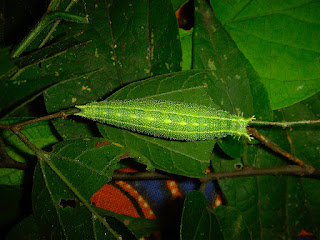For example, last spring when we were in Tucson we were at the beginning of a trail in our favorite Saguaro East National Park when we snapped a picture of a rather scruffy juvenile road runner. Then last month (we had gone out to spend Thanksgiving with our son and his family) when we went to exactly the same place, there was an adult roadrunner in all its mature glory, which again allowed us to snap it. Of course we can't prove it's the same one...
Going back much earlier in the year: The western population of Whooping Cranes that summer at Wood Buffalo National Park, and then migrate in winter down to Aransas National Wildlife Refuge, was thought to be vulnerable to some disaster which could wipe out the entire population, so for several years there has been an effort to develop a separate eastern population in Wisconsin as a backup. These were captive-reared at first, then led on their first migration to a winter spot in Florida by ultra-light aircraft. After they had learned the way, it was hoped that new generations of captive-reared cranes woud follow the older cranes to the migration spot. This is a very complicated endeavor, and the cranes don't always cooperate. Last winter for example two young males, one much younger than the other, became buddies, and refused to follow any adult cranes, taking off on their own. They wandered around a bit, and then decided to winter in north-east Arkansas. We heard that they were hanging out in some wet fields about forty minutes from our house, and went looking for them.
We located them and told Game and Fish we would try to keep an eye on them. This was of course a great pleasure and we went down a couple of times as week. It was impossible to stop taking pictures of them.
They spent almost all their time within a few feet of each other.
Here is the older one, with his purer white feathers. You can see all the electronic equipment he is wearing which gives a constant account of his whereabouts.
The younger one still has his juvenile plumage. These pictures were taken in early February.
I only meant to take another picture of the crane foraging, and inadvertently caught it just as it accidentally stepped on a meadowlark hidden in the grass. Both birds jumped out of their skins.
There is a sad ending. The younger crane formed a bad habit of feeding in ditches alongside the road, and he was killed by a truck. The other one made it back to Wisconsin and is now living "in a wonderful marsh." We will wait to see if he comes back to Arkansas for the winter.
In a previous post I wrote about the plants we systematically added to our yard to attract various species of butterflies to breed here. I mentioned in that post that we did not do the same thing to attract moths into our yard, but that just because of the diversity of plants we had, we ended up by attracting numbers of moth species as well, which we only realize when we discover their caterpillars. Here (trying not to be too boring about it), are a dozen (we could easily show three or four more dozen). These are all moth caterpillars (they may not always look like it) from our garden.
1. Saddleback Caterpillar
2. Io Caterpillar
3. Snowberry Clearwing
4. Eastern Tent Caterpillar.
5. Milkweed Tussock Caterpillar
6. The Laugher
7. Spiny Oak-Slug
8. White-spotted Prominent
9. Unicorn Caterpillar
10. White Furcula
1l. Curve-lined Owlet
12. Tersa Sphinx Moth
Just for fun, I will add on to the end of my next blog twelve more moth caterpillars found in our yard, and keep doing this on further blogs until I can't find anymore.



















































